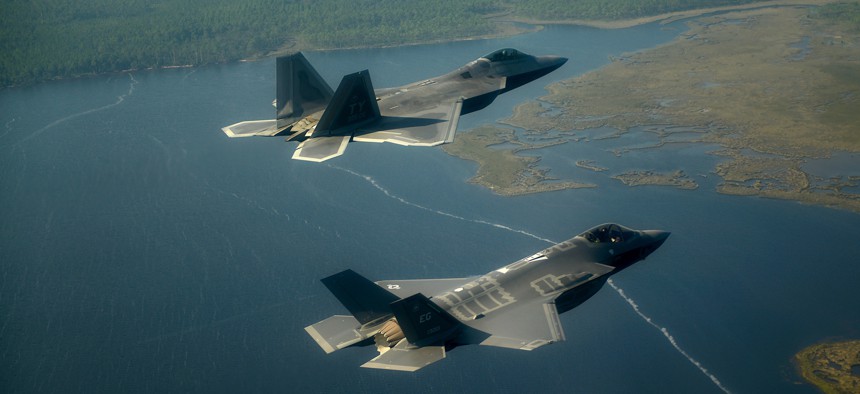
An Air Force F-22 Raptor (left) flies with an F-35 Joint Strike Fighter over Florida. USAF photo by Master Sgt. Jeremy T. Lock
Air Force Officers Give New Details for F-35 in War With China
For the first time, key officers lay out how they’d deploy the stealth F-35 and F-22 in an all-out war with China.
U.S. Air Force officials for the first time said publicly how they’re planning to use the F-35 Joint Strike Fighter in a war with China.
The bottom line: a lot needs to change in the way the Air Force uses its warplanes in battle.
“If you put a fourth-[generation F-15 or F-16 fighter] in there, they’re gonna die,” said Maj. Gen. Jeff Harrigian, who is finishing up a tour at the Pentagon where he has been building the plans for integrating the F-35 throughout the Air Force. He and Col. Max Marosko, the deputy director for air and cyberspace operations at Pacific Air Forces in Hawaii, detail how the F-35 would be unleashed in a new report published Thursday by the Mitchell Institute for Aerospace Studies.
“In our minds, what this comes down to is the ability to kill and survive,” Harrigian said.
Air Force officials frequently talk about how the advanced technology on the F-35 and other jets will give it an edge on the battlefield, but this report offers an unprecedented detail from a senior officer of how the plane could be used in war.
In the fictitious war of 2026 they present, the enemy tries to jam radar and radio signals, allowing only stealthy planes like F-22 and F-35 fighters and B-2 and B-21 bombers to fly safely and strike targets, which are guarded by mobile surface-to-air missiles.
The Pentagon would spread its fighter jets around the Pacific in small numbers to military and civilian airfields, some as far as 1,000 miles from the battlefield, to prevent enemy ballistic and cruise missiles from delivering a devastating knock-out blow to a base. Today, the Pentagon tends to concentrate the majority of its planes at regional super bases.
“During the initial days of the conflict, F-35s occasionally return to their bases - only to discover several are heavily damaged from enemy missile attacks,” Harrigian and Marosko write, in their warplay. Those F-35s must divert to civilian airfields. By this time, the F-22 and F-35 won’t need air traffic controllers as their high-tech computers will guide them to runways, even in bad weather.
Older fighter jets, like F-15 and F-16 fighters, which are more easily spotted by enemy radars, must fly at greater distances from the battlefield, out of the range of deadly, long-range surface-to-air missiles.
The report does not name China as the enemy, instead saying the fictitious war takes place in “a key region abroad,” where in one detailed scenario an F-35 must divert to a base in Australia. Only China and Russia have fifth-generation fighters and advanced defenses the F-35 would be deployed to face, and Russia is out of range. Australia is expected to fly its own F-35s in the future — and could fix any U.S. Air Force F-35s damaged in combat. However, the same concepts could be applied to a war with Russia.
In order to win this future war, much needs to change in the way the Pentagon employs its aircraft, Harrigian and Marosko said. F-22s and F-35 must fly missions more frequently than current military aircraft. Unlike most missions today, they will receive targeting information from command centers through high-tech computers and communications equipment as they fly to the battlefield. Connectivity improvements between old planes and new ones is also a must.
The Air Force needs to deploy its F-22s and F-35s more quickly from bases in the United States since the enemy could move assets around the battlefield, Marosko said. And when they deploy, they must do it with less equipment and fewer people.
The newer fifth-generation planes also would need to collect and upload data to command centers and other aircraft more quickly. Harrigian said the data also needs to get pushed into the cloud quickly.
“There’s going to be a huge reliance on all that data … getting back to the mother ship,” Marisko said.
The goal of their paper is to spur a discussion about the ways to use the nation’s most advanced fighter jets on the battlefield in conjunction with older American and allied warplanes and forces.
“There’s more work that needs to be done with this,” Harrigian said.
Fifth-generation refers to aircraft that possess a combination of stealth, high-tech computers, and sensors baked into a warplane, allowing it to act as the quarterback over the battlefield, collecting data and sharing intelligence and targeting information with other aircraft.
“Everybody gets better” when a fifth-generation aircraft like the F-22 or F-35 flies over the battlefield, Harrigian said.
The timing of the report is notable as the Air Force is expected between August and December to declare its first squadron of F-35s ready for war. That means a regional military commander could request those planes for combat. The Marines declared its F-35s ready for war last year, but they have not been used in the air campaign against ISIS, Afghanistan and in Africa, all areas where the military has bombed enemy strongholds in recent years.
Harrigian, an F-22 pilot, soon will take over as the commanding general in charge of the air campaign against ISIS in Iraq and Syria.
The Air Force’s F-22s were deemed battle ready in 2005 but were not deployed until 2014, when American warplanes began bombing ISIS strongholds in Syria, which had sophisticated air defenses.
